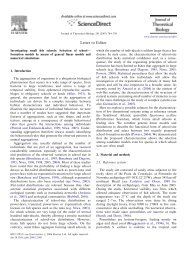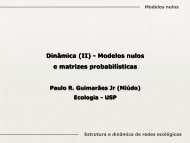SUPPLEMENTARY INFORMATION - Paulo R. Guimarães Jr.
SUPPLEMENTARY INFORMATION - Paulo R. Guimarães Jr.
SUPPLEMENTARY INFORMATION - Paulo R. Guimarães Jr.
Create successful ePaper yourself
Turn your PDF publications into a flip-book with our unique Google optimized e-Paper software.
5956 <br />
(Lengendre and Legendre 1998). The similarity between two species, i and j, is defined<br />
as S(i, j)=a/(a+b+c), where a, b, and c represent the number of shared interacting<br />
species, the number of interactions specific to species i, and the number of interactions<br />
exclusive to species j, respectively.<br />
Because differences in degree affect Jaccard estimates, we also performed partial<br />
Mantel tests controlling for degree (the pairwise distance in degree was calculated as the<br />
absolute difference in degree between two species). Hence, this partial test can discern<br />
whether phylogeny affects strictly with whom species interact, independently of the<br />
total number of interactions of each species. Because partial Mantel test can inflate<br />
Type I error rates (e.g., Raufaste and Rousset 2001, Castellano and Balleto 2002),<br />
employing different null models may be more appropriate depending on the<br />
characteristics of the data (Legendre 2000). We performed permutations of the residuals<br />
and of the raw data for all phylogenies (the second method was suggested by Legendre<br />
[2000] to avoid increased Type I error rates associated with data skewness), employing<br />
the software developed by Bonnet and Van de Peer (2002). Because all results were<br />
qualitatively identical, we report values obtained with permutation of residuals.<br />
TAXONOMIC DIVERSITY AND COEXTINCTION SIMULATIONS<br />
As a surrogate for phylogenetic diversity, we estimated taxonomic diversity of plants<br />
and animals in the largest available phylogenies (23 plant and 27 pollinator phylogenies<br />
with more than 30 species, and 15 bird phylogenies with more than 15 species; see<br />
Supplementary Methods). Briefly, path length weights between species increase as they<br />
are more distantly related taxonomically (i.e., species of the same genus have a distance<br />
of 1 whereas species from different genera within the same family have a distance of 2,<br />
and so on), generating a matrix of pairwise taxonomic distances. The mean taxonomic<br />
distance between all species was employed as an index of taxonomic diversity in<br />
subsequent regressions (Clarke and Warwick 1998).<br />
Extinction cascades were simulated for the 10 largest communities (all having<br />
more than 40 animal and plant species) with available taxonomic affiliation, following<br />
Memmott et al. (2004). After one species is removed, species left without any<br />
interaction go coextinct. Species removal started from the most specialized (least-<br />
linked) to the most generalized (most-linked) species, which was proposed as a more<br />
plausible extinction sequence because specialist species tend to be less abundant than<br />
generalists (Jordano et al. 2003; Memmott et al. 2004; Vázquez and Aizen 2004).





